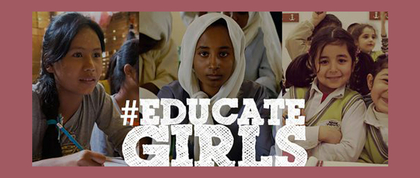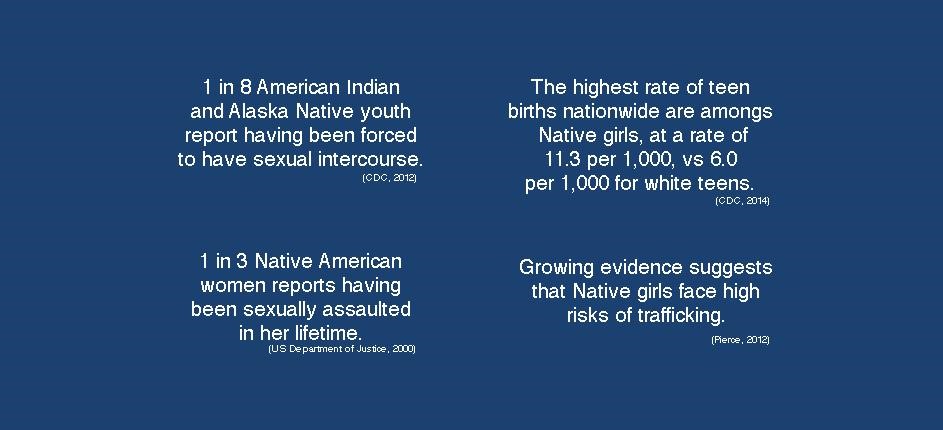
A Perspective Piece by Diana Klatt, MPH Student
Photo Credit Above: Sayfty "Girls Education is not considered a priority worldwide, this needs to change!"
The most vulnerable population might not be who you think they are. Often times when we think of vulnerable populations, we automatically think of low- and middle-income countries (LMICs) that are often referenced on the news. But what about populations right here in the United States?
The extraordinary hardships that Native Americans experience is no secret. Since Standing Rock, there has been a shift in attention and a spotlight has been cast on the Native American Nations in the US, providing them a podium to finally stand at. This political spotlight has brought to focus the extreme difficulties that Native Americans continually face and has ignited collaborations between local, national, and international organizations.
Within this already disparate community, there is an even more vulnerable population: Adolescent Native American girls. These girls are distinct because they face unique challenges due to not only a historic, systemic oppression but also from challenges passed down from ancestors/generational commitment as well as the typical challenges that face all girls in the 10-14 age range.
By the age of 15, roughly 50% of girls are out of school. To put this into perspective, 90% of girls are enrolled in school and start the primary school experiences, so there is no misunderstanding of the importance of education. It is at this age girls are burdened with “caregiving responsibilities” associated with reaching puberty as well as generational commitment. Many girls feel the pressure of putting aside academic pursuits in order to provide for their families or possibly even to escape their families and provide for themselves.
Native American youth are ranked the lowest in high school graduation rate. Unsurprisingly, they are also continually the lowest represented in the collegiate systems. In response to the surge of promotion towards STEM fields, there has been an increase in academic programs that are populated by all minority groups with the exception of Native Americans, who have had a minute increase in male representation but stagnant female representation. Studies show that when in academic settings working with hands on projects, mixed groups of students (as in both male and female students) will result in the male students doing the work while the female stand behind; however, when female students work in a group together, without males present, they will dive into problem solving. This problem is exacerbated in the Native American Nations as the lack of resources for this population provides more in favor of males. In order to address this issue, female leadership and mentorship must work together to access this population while they are still in school, because once they leave, it is difficult to engage them.

There are substantial benefits of investing in girls’ education, including an increase in the economy and immense social benefits for all members of that community. According to the World Bank, the return on one year of secondary education for a girl correlates with an increase in wages later in life as high as a 25%. Outside of personal empowerment, educated women will take a greater economic role in their families and communities, and tend to reinvest 90% of what they earn into their families and communities. When you observe the effects of increased education at the societal and national levels, the power of increasing education and resources for females leads to a 0.3% increase in the average gross domestic product (GDP). For a community that is severely under-resourced, this means major impacts. It also gives females the power to go out and bring back sovereignty over their land, which addresses parts of over-regulation. Seems like a massive task to take on, right? Not if we work together, collaboratively.
Collaboration is the key element in global public health. Without collaboration, we are constantly trying to reinvent the wheel. Many concepts can be used as a baseline between populations to help address issues but the thing that is starkly different between indigenous people in other countries versus the US is that, whilst all of these populations are under resourced, only the US Nations are over regulated. This is where challenges arise and collaboration is crucial. The key here is that the collaboration needs to be a true collaboration. For many years, institutions have gone through these communities, collecting data without full permission and then making statements with the data and not sharing the raw data or the findings with the nation they collected information from. How is anyone supposed to benefit from a one sided “partnership”? The answer is, you cannot. External organizations can exist in this space but only in full collaborative, and ally-based, capacities, meaning that they must allow the community to be fully involved in data collection and initiative creation. The goal is to increase sovereignty for each nation. This is what the GIRL Center has done. The Population Council founded the GIRL Center and works with many indigenous organizations throughout the Americas. They all work together to promote each other’s work and to help create the best programming to empower girls in all endeavors.
I would like to say thank you to the Population Council for hosting a panel of such powerful female, Native American leaders who educated me and provided me with the information to be able to be a better ally to the Native American community. I do not speak as an authority on this subject matter but rather as someone bringing attention to an extremely important, and overlooked, problem here in the United States. If you have the time, please watch the panel discussion on the evidence-based programming being done in the Americas below.
Facebook Live of Panel Discussing the issue during the 73rd UN General Assembly:
https://www.facebook.com/popcouncil/videos/473112013188845/
Societies and Organizations Represented at the panel:
Population Council: Indigenous Adolescent Girls’ Empowerment Network (IMAGEN) (https://www.popcouncil.org/research/the-indigenous-adolescent-girls-empowerment-network-imagen)
The White Buffalo Calf Women’s Society (WBCWS)
American Indian Science and Engineering Society (AISES)
My Native Sisters’ Fire (https://www.facebook.com/My-Native-Sisters-Fire-Inc-126494391504496/)